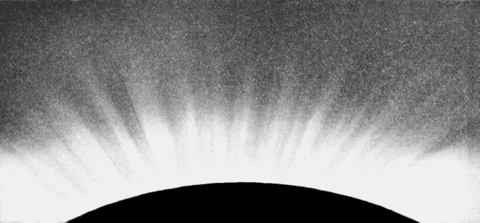which, judging by the results obtained by several observers during the eclipses of 1870, 1878, and 1898, was at least equal to that of the full moon, it is difficult to understand how the light of the corona can be due largely to reflection of rays from the sun, or even to the incandescence of dust particles, for from sources of these kinds, which emit a great preponderance of invisible infra-red rays, the bolometer would have given large positive deflections. . . The important result of a comparison of the radiations of the inner corona, the full moon, and the daylight sky somewhat remote from the sun is that while the three are roughly of equal visual brightness, the corona is effectively a cool and far from intense source, while the moon and sky are effectively warm and many fold richer in radiation. Hence it would appear plausible that the corona merely sends out visible rays and that its light is not associated with the great preponderance of long wave-length rays proper to the radiation from bodies at a high temperature. If this be so the coronal radiation might be compared with that from the positive electrical discharge in vacuum tubes, in which, as researches of K. Angstrom and R. W. Wood, have shown, there is neither an infra-red spectrum nor a high temperature.

Fig. 9. South Polar Streamers. Eclipse of 1900. Photographed with a Telescope of 135 feet Focal Length by Mr. Smillie, of the Smithsonian Eclipse Party.
These conclusions are of so great importance that it is very desirable that the observations upon which they depend, should be repeated at other eclipses. It is, therefore, very unfortunate that Mr. Abbott at the recent eclipse at Sumatra was prevented by clouds from carrying out the observations which he had traveled so far to obtain. Other observers, however, were no more fortunate. Professor E. E. Barnard was provided with a telescope of 611⁄2 feet focus, and with plates forty inches square, but was prevented by clouds from obtaining results of much value. This was the fate, also, of many other observers from different countries, who had taken stations in different parts of Sumatra. Results of value were obtained, however, by the party from the Massachusetts Institute of Technology, whose photographs of the corona are unsurpassed. At the Island of Mauritius, also, the English astronomers obtained valuable results. As a whole

